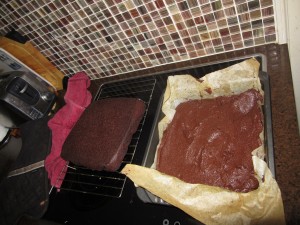So Michael and I had an engagement party and spent ages trying to work out an appropriate present. In the end we picked something similar to one of our presents. For our present we received a three layered glass jar filled with lollies. I decided that it would be nicer to have some home baked goodies in the jars as well.
I also had to make some food for Michael’s last day at his legal placement so decided to make some quick and easy brownies.
Recipe:
- 250g of melted butter
- 1 1/3 cups of plain flour
- 2 1/4 cups of sugar
- 3/4 cup of cocoa powder
- 4 eggs
- 1/4 teaspoon of baking powder
Combine all ingedients in a bowl and mix until smooth. Poor into a 20 cm square cake tin and bake for 50 minutes at 170 C. Allow to cool before cutting.
I made two brownies so Michael had enough and there was also some for the present. It doesn’t take long at all and is super easy and tastes yummy.
Next up I decided to make something else super easy which was caramel slice.
The recipe I used was from taste but slightly modified. Taste is where I love to go to get any recipes I don’t have.
Recipe:
Bottom Layer:
- 125 g of butter
- 80 g of caster sugar
- 190 g of plain flour
Cream the butter and sugar, then add in the flour and combine. Knead until it forms a smooth ball. Spread into a 20 cm cake tin and bake at 160 C for 15 minutes. Remove and cool for 15 minutes.
Middle Layer:
- 395 g of sweetened condensed milk
- 2 tablespoons of golden syrup
- 40 g of butter
Heat on medium until the mixture thickens and is a caramel colour. This usually takes about 10 – 15 minutes and needs to be constantly stirred. Pour onto the base layer and bake at 160 C for 12 minutes. Leave to cool for 3 to 4 hours.
Top Layer:
- 150 g of dark chocolate
- 20 g of butter
Combine in a microwave safe bowl and heat for 1 minute at a time. Stir the mixture between every minute and continue heating until smooth. Pour over the middle layer and leave to cool in the fridge.
Cut up and serve once all the layers have set.
Unfortunately, I forgot to get some pictures of this which was sad as it looked really nice.
Finally, David got some chocolate from Haigh’s Chocolates.
Now that I had all the pieces I put everything in the jar and wrapped it up. It looked really cool and I hope they liked all the food inside.





